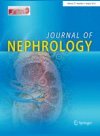Phenotypic outcomes of PKD1 compared with non-PKD1 genetically confirmed autosomal dominant polycystic kidney disease
Abstract
Background
Autosomal Dominant Polycystic Kidney Disease (ADPKD) represents the most common monogenic cause of kidney failure. While identifying genetic variants predicts disease progression, characterization of recently described ADPKD-like variants is limited. We explored disease progression and genetic spectrum of genetically-confirmed ADPKD families with PKD1 and non-PKD1 variants.
Methods
In this observational study, we evaluated the clinical (ADPKD-related complications, estimated glomerular filtration rate (eGFR) decline, and progression to kidney failure), radiological (height-adjusted total kidney volume (ht-TKV)), and genetic characteristics of ADPKD families referred to the Irish Kidney Gene Project. Logistic regression and Kaplan–Meier analyses examined relationships between genetic variants and disease progression.
Results
Genomic sequencing was performed on 261 ADPKD families, and 75.8% (198/261 families, comprising 391 individuals) were identified to harbor pathogenic/likely pathogenic variants; 74.2% (147/198) PKD1 families and 23.2% (46/198) non-PKD1 families, which include PKD2 (n = 29 families), IFT140 variants (n = 4), ALG5, DNAJB11 and NEK8 (n = 3 each), ALG8 and ALG9 variants (n = 2 each). The remaining 2.6% (5/198) accounted for non-ADPKD variants.
Compared to PKD1, non-PKD1 families were characterized by a milder phenotype; milder eGFR decline (− 1.4 mL/min/1.73m2/year vs. − 3.2; p < 0.001), smaller ht-TKV (449.7 mL/m vs. 1769; p 0.002) and a delayed progression towards kidney failure (73 vs. 52 years; HR: 0.12, p < 0.001 [95% CI: 0.07–0.19]). ADPKD-NEK8 heterozygotes demonstrated earlier progression to kidney failure (average age 8 vs. 49 years for PKD1; Bonferroni-corrected p 0.017).
Conclusion
Non-PKD1 variants have heterogeneous phenotypic and genotypic attributes resulting in milder disease, although ADPKD-NEK8 is an important exception with early progression.
Graphical abstract




